Lingonberry Wine is fantastic, but the berries are hard to find. This Faux version uses cranberries & blueberries to replicate it, accurately!
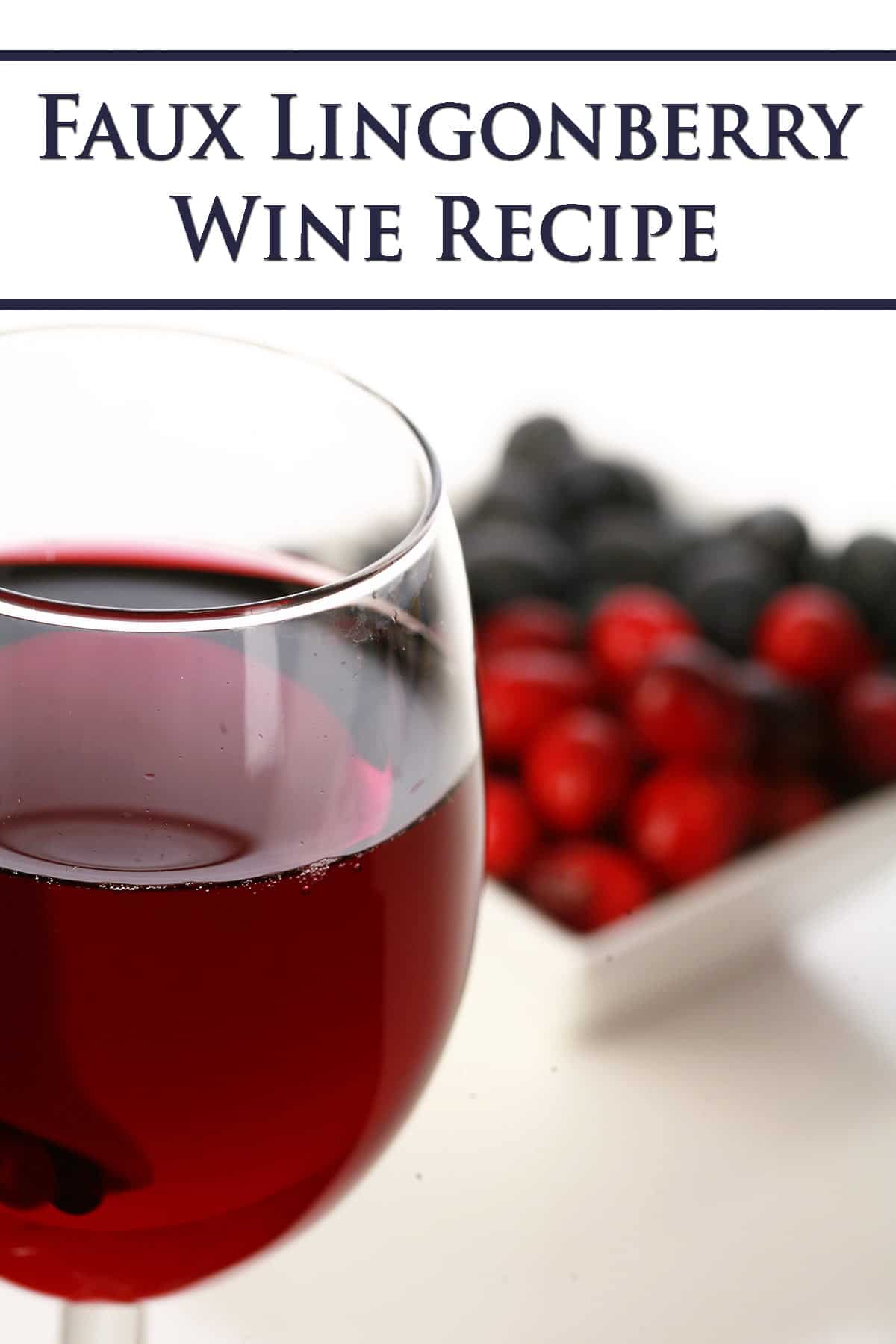
Ah, Lingonberry wine - I love it, but it can be hard to come by. Enter: My fake version!
Back home in Canada, I remember my first taste of it - though it's called Partridgeberry Wine there. Ah, beautiful.
Though I'd never been a fan of red GRAPE wines, Partridgeberry (lingonberry!) wine became a fast favorite for me.
Not only was it great for drinking, it was a favorite ingredient for cooking wild game. It was one of 2 secret ingredients in my moose stew. Oh, yum. It's been far too long...
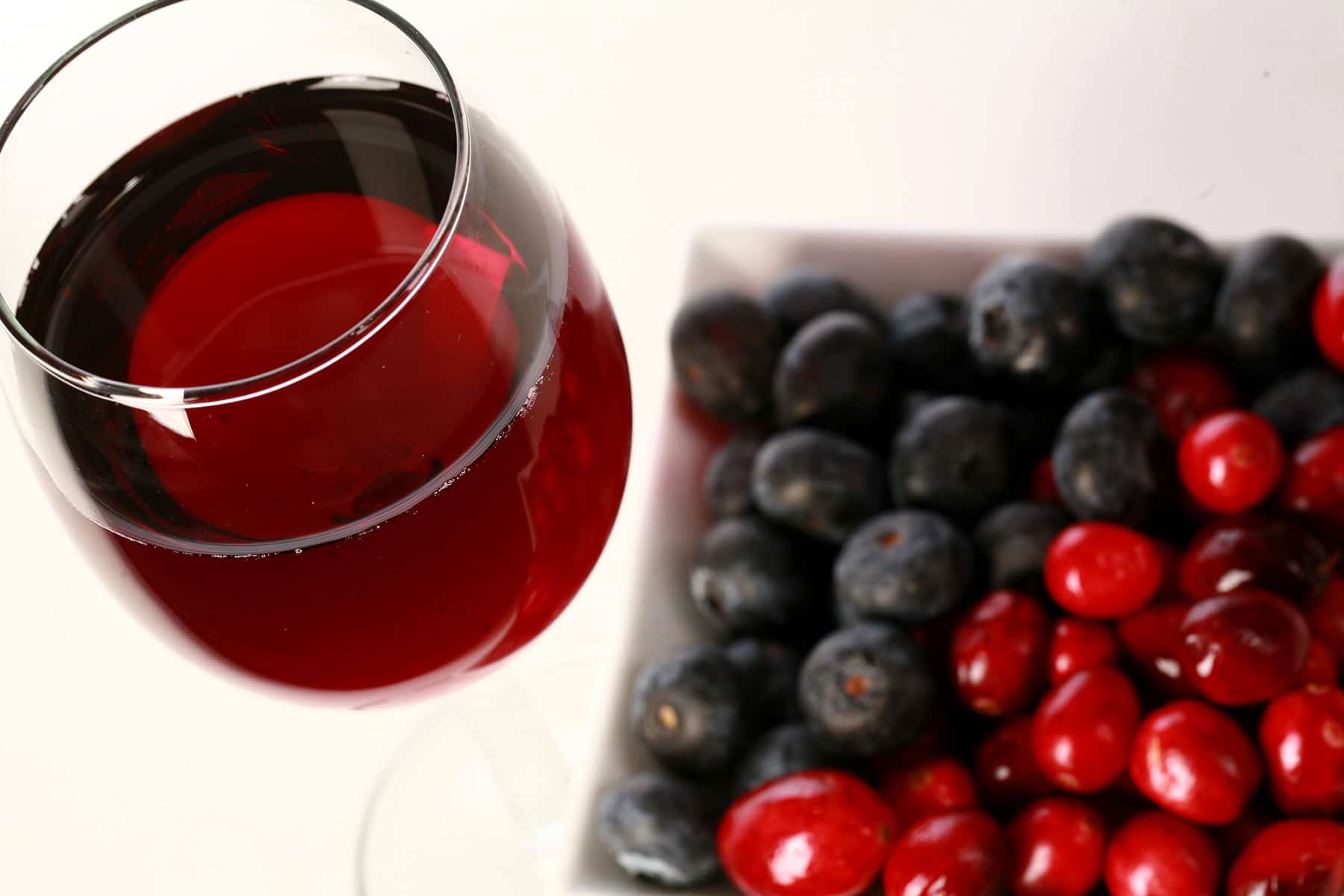
What Are Lingonberries?
For those not in the know - or not living near an IKEA - Lingonberries/partridgeberries are a small berry that grows in boreal and tundra areas of Canada, Europe, and Asia.
Tiny, round, ruby-red berries, they taste like a cross between a cranberry and a blueberry.
Lingonberries make fantastic muffins, cheesecake, pies, jams, etc... when you can get them. You know, aside from the preserved products at IKEA.
Homemade Lingonberry Wine
A couple of years ago, I was inspired by lingonberry fudge offered at a local retailer - and I went on a search for wholesale lingonberries.
I found em, bought a 25 lb case, and made MAGIC. Together, my husband and I made a 5 gallon batch of the most amazing Partridgeberry Wine
I've ever tasted.
Most amazing wine that either of us has had, for that matter.
Though our supply of wine was dwindling last year, we didn't end up buying a case of lingonberries, before it was too late.
This year, we planned ahead... only to have those plans thwarted by mother nature. A bad crop season meant NO partridgeberry wine for us this year!
Luckily, we'd been notified that this may be the case, so I started a "Plan B" - I created a "faux lingonberry" wine!
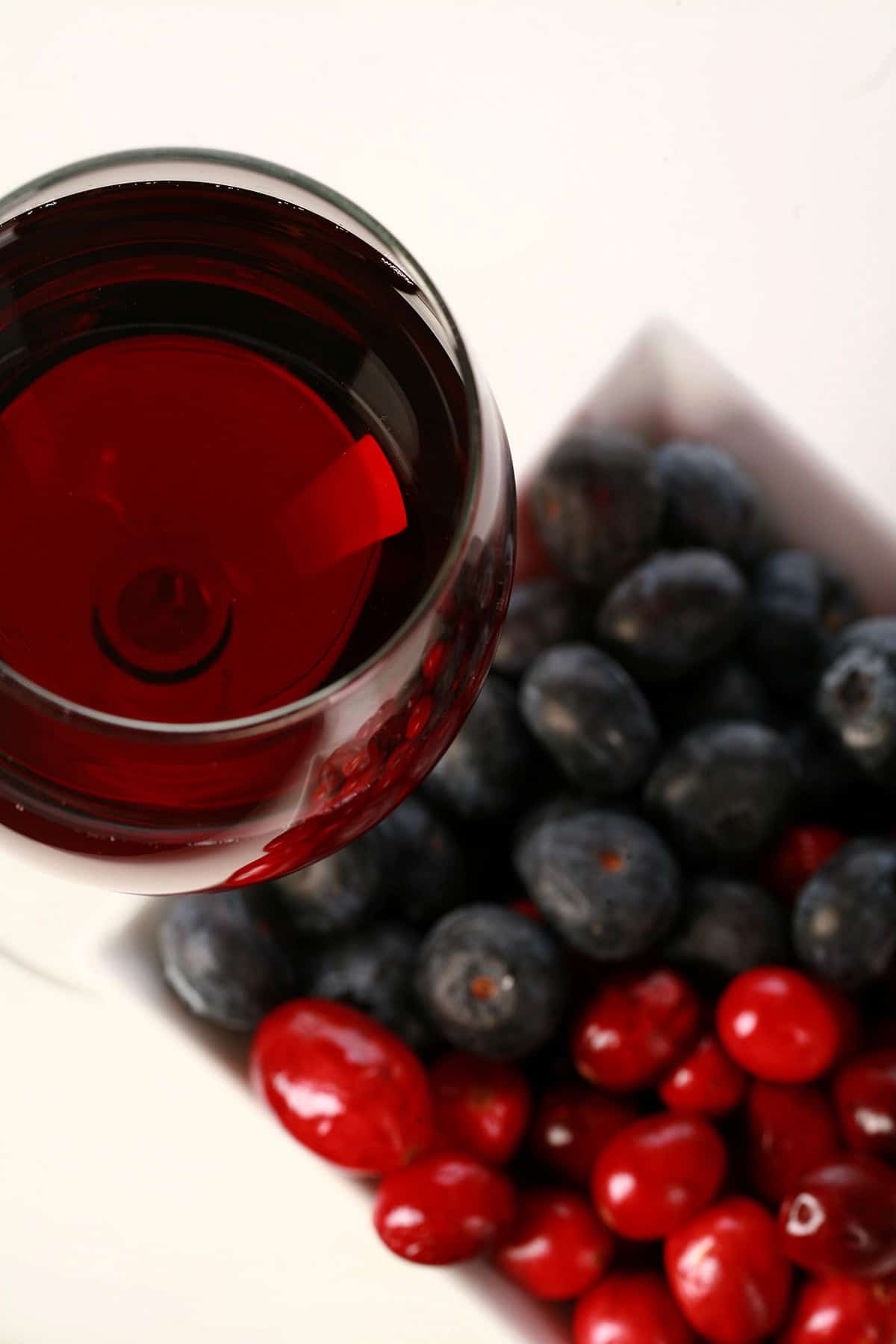
If You Can’t Make it, Fake it!
Using the "like a cranberry crossed with a blueberry" flavor profile, I experimented with proportions, and came up with a VERY passable "lingonberry" wine.
The color was only slightly different from the original thing, and the flavour is SO close, it'd fool most lingonberry fans.
Oh, this is good stuff! While this recipe is for a 1 gallon batch, it can easily be scaled to make 5 or 6 gallon batches - or more, if you’d like! More on that in a bit,
One especially nice thing about this recipe: Lingonberries can be tough to ferment.
They seem to have some sort of natural preservative, and it was stressful to brew that first batch - for a couple weeks, we were worried we were going to lose the batch! This recipe? No worries. It ferments easily and beautifully!

Faux Lingonberry Wine Ingredients
Bottled Spring Water
While using tap water can be an option, we opt to use jugs of spring water, for a couple of reasons..
First of all, life in Minneapolis opened our eyes to the fact that tap water doesn’t always taste good (or even potable, to be honest!).
While I’ve lived in areas where the tap water tastes fresh and clean (without a filter even!), we know that’s not the case for everyone. Bottled spring water won’t introduce any weird, undesirable flavours to your wine.
Additionally, there’s the convenience factor. Not only is it clean tasting, it’s pre-measured, sterile, and handy.
However, if your tap water is consistently tasty and safe, feel free to use that instead of bottled.
Fresh or Frozen Berries
This recipe works well using either fresh or frozen cranberries or blueberries, so use what is most convenient for you.
If both are convenient, I very slightly lean towards using frozen, myself.
Freezing and thawing berries tends to break them down a bit, so they release their flavours and juices more readily than fresh ones do.
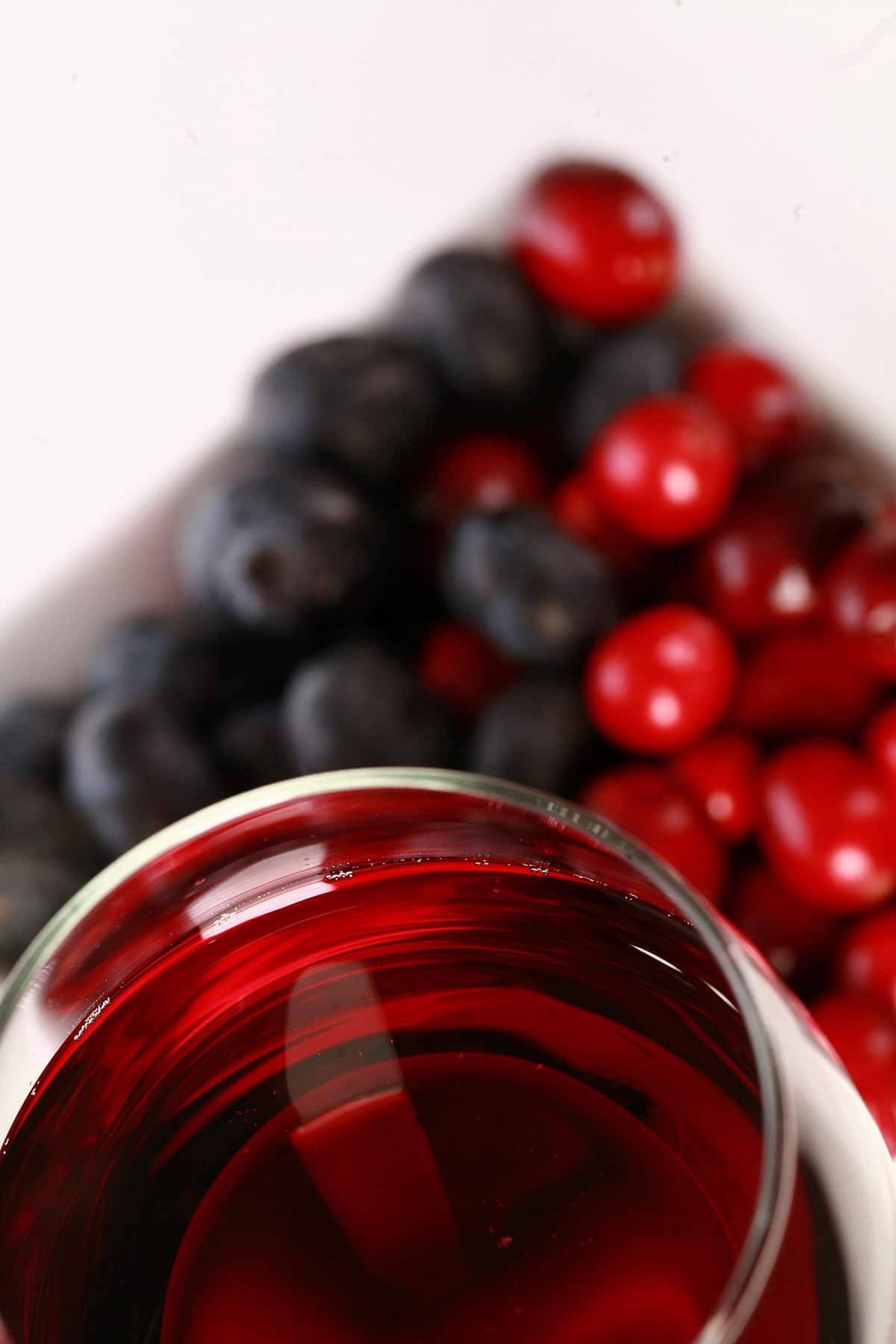
Sugar
We prefer to use plain white granulated sugar for this wine.
It’s a good neutral flavour, and I really think that brown sugar or maple syrup would overwhelm the flavour of the berries.
Alcohol Content
Aside from flavour/sweetness, sugar also contributes to the final alcohol content of the wine.
Your wine’s final ABV will vary wildly dependent on a couple things: how much sugar you add, and what kind of yeast you use (more on that in a bit)
Any amount of sugar will result in a higher alcohol content than making the same wine without sugar added. Sugar - both in the base wine itself, and from the added sugars - is what feeds the yeast, the yeast eats up the sugars and gives off alcohol as the byproduct of that process.
More sugar = more food = more alcohol... to a point, anyway. About that...
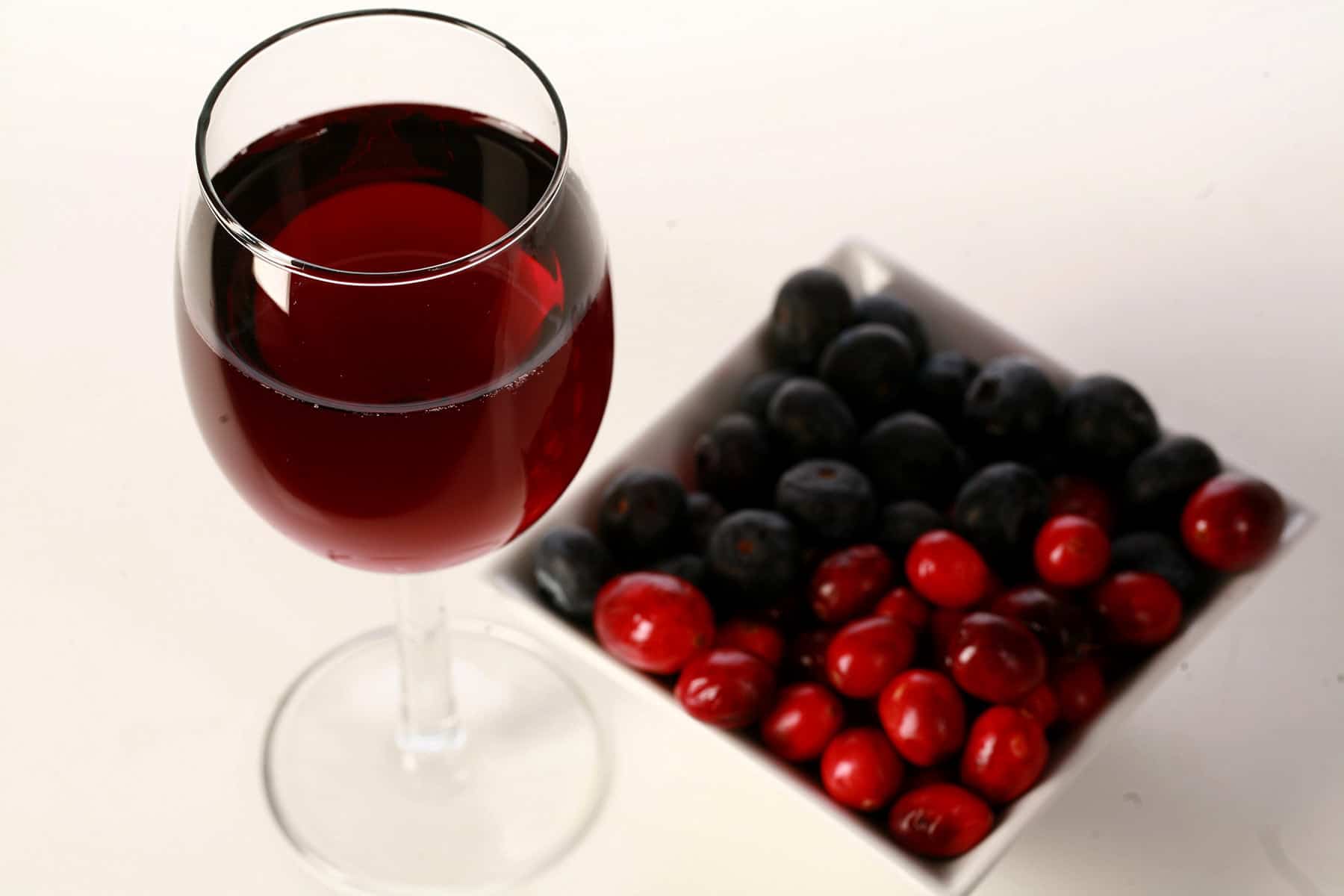
Yeast
The type of yeast you use will impact the alcohol content of the final product.
Yeast organisms don’t have an *unlimited* capacity to process sugar into alcohol. At some point, the environment they’re living in - the brewing wine - becomes too high in alcohol for the yeast to survive. They die off, the fermentation stops.
Different types of yeast have different tolerances for alcohol in the environment. That is, some yeast will be able to survive higher amounts of alcohol in the wine, so they’ll continue producing it longer than some other types.
Some types of yeast will bring you to something like an 8% ABV, while others will let things run wild until close to 20% ABV.
It’s good to know what you have in mind, when you choose your yeast. For this wine, we’ll usually use Red Star’s “Montrachet” yeast.

Everything Else
Everything else in this recipe is technically optional, but contributes to it finishing as a well balanced wine. These ingredients include:
Acid Blend - Balances and rounds out the flavours.
Pectic Enzyme - Breaks down fruit, especially as it relates to preventing “haze” from the pectins.
Yeast Nutrient - Gives a boost to the yeast.
White Grape Juice Concentrate - Enhances the body and mouth feel of the wine.
Back Sweetening Your Fake Lingonberry Wine
Sometimes - usually, even - you’ll find that the yeast went a bit too far with their smorgasbord, and you end up with a peach wine that’s not as sweet as you’d like it.
... and that’s when you back sweeten it! You can read my How to Stabilize and Back Sweeten Wine post for information on how to back sweeten it.

How to Make Faux Lingonberry Wine
If you haven't attempted making wine before, don't be intimidated! Check out our primer to home brewing:
- Wine Making At Home, Part 1: Why?
- Wine Making at Home, Part 2: Equipment to Get Started
- Wine Making at Home, Part 3: The Brewing Process.
- Wine Making at Home, Part 4: How to Stabilize and Back Sweeten Wine
Just a small handful of entries, and you'll be good to go!
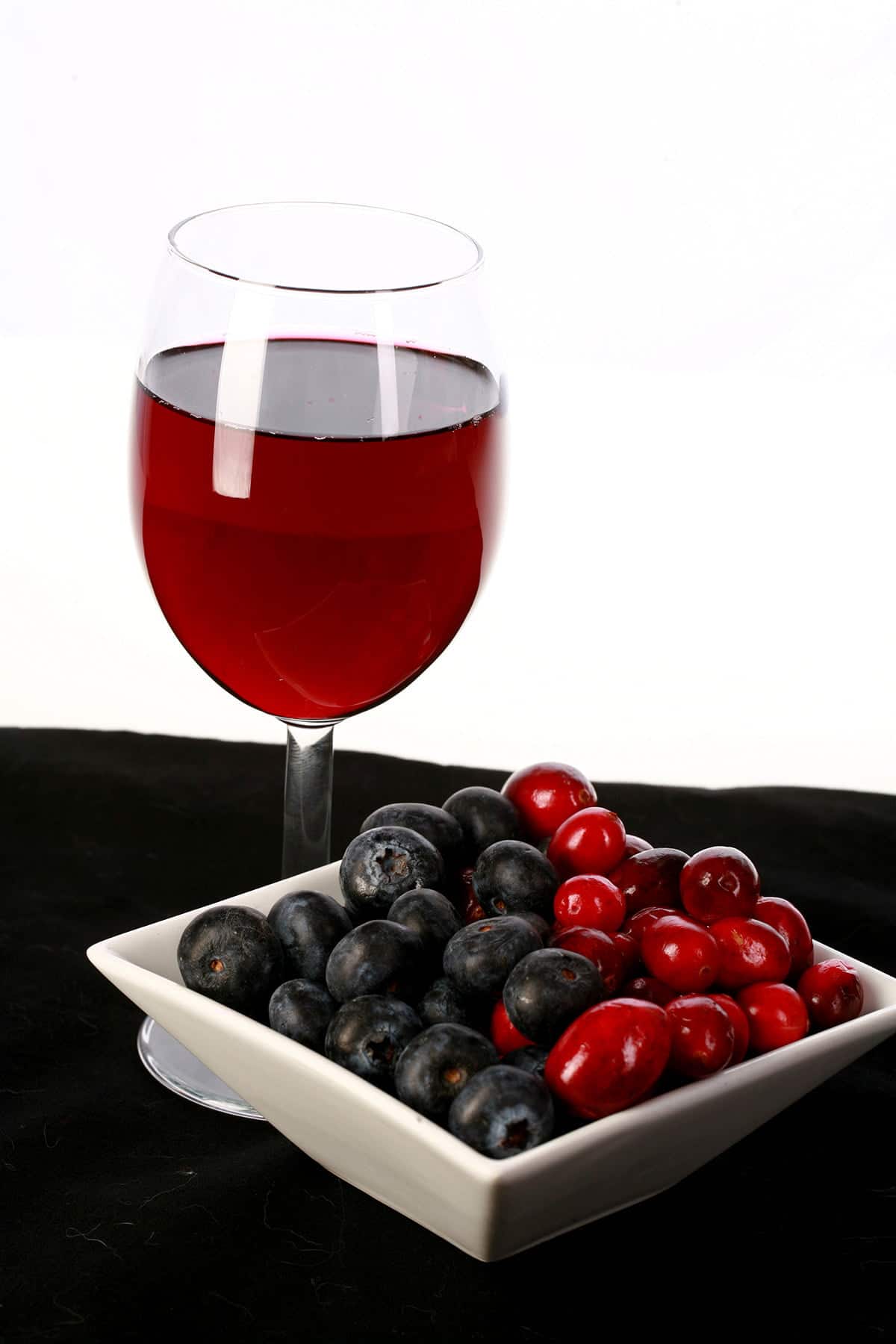
Scaling This Wine Recipe
Good news: you can easily scale this wine recipe up. In fact, there's a function inside the recipe card itself to do the math for you!
One note, though: You don't need to multiply the yeast, but the software doesn't know that. We will use one pouch of yeast for anything from 1-5x gallons, and then 1 pouch for every 5x batches beyond that.
Also, for anything that scales to awkward measurements, it’s perfectly ok to round up or down to the nearest easy measurement (¼ tsp, etc).
As a related note: The recipe software is definitely geared towards cooking, not wine making. Therefore, you can pretty much ignore all of the info it gives you: The nutritional info is calculated on everything that goes into the wine.
It does not take into account how much sugar will be fermented out, how much volume is lost to racking, the fact that the fruit pulp is removed before the final product, etc.

"More than Poutine" is a Canadian cookbook like no other - written by a Canadian living away, it includes both traditional home cooking recipes, as well as accurate homemade versions of many of the snacks, sauces, convenience foods, and other food items that are hard to come by outside of Canada! Order your copy here on this site, through Amazon, or through any major bookseller!
More Home Brewing Recipes!
While you've got your current homebrew fermenting away, why not consider putting a batch of something else on, to occupy your wait time? Here are a few of my other wine, cider, and mead recipes:
Wine Recipes
Banana Wine Recipe
Blackberry Wine Recipe
Blackcurrant Wine Recipe
Blueberry Wine Recipe
Cherry Wine Recipe
Cranberry Clementine Christmas Wine Recipe
Cranberry Wine Recipe
Lychee Wine Recipe
Mango Strawberry Wine Recipe
Mango Wine Recipe
Mint Wine Recipe
Lychee Wine Recipe
Partridgeberry Wine Recipe
Passionfruit Wine Recipe
Peach Wine Recipe
Stone Fruit Wine Recipe
Strawberry Wine Recipe
Ube Wine Recipe
Watermelon Wine Recipe
Mead Recipes
Black Cherry Mead Recipe
Blueberry-Clementine Mead Recipe
Blueberry Mead Recipe
Clementine Mead Recipe
Pumpkin Mead Recipe
Wildflower Mead Recipe
Cider & Miscellaneous Homebrew Recipes
Hard Apple Cider Recipe
Home Brew Hard Iced Tea Recipe
Maple Hard Apple Cider Recipe

Share the Love!
Before you drink up, be sure to take some pics of your handiwork! If you post it to Bluesky, be sure to tag us - @CelebrationGen. We're also on Pinterest, so you can save all your favourite recipes to a board!
Also, be sure to subscribe to my free monthly email newsletter, so you never miss out on any of my nonsense.
Well, the published nonsense, anyway!
Faux Lingonberry Wine
Equipment
- 2 gallon fermenter bucket and lid
- 1 - 2 1 gallon glass carboys & stoppers
- 1 air lock and stopper
- Siphon, siphon tubing.
Ingredients
- 12 oz Frozen Blueberries
- 10 oz Frozen Cranberries
- 3 lbs Granulated Sugar
- 1 can Welches White Grape Frozen Juice Concentrate Thawed
- 1 gallon Spring Water will use slightly less
- 1 teaspoon Acid Blend
- ¼ teaspoon Pectic Eenzyme
- 1 teaspoon Yeast Nutrient
- 1 packet Red Star “Montrachet” Wine Yeast
Instructions
- Allow the blueberries and cranberries to thaw. Puree until thick but runny. Strain juice into a large pot, reserving the berry pulp. (Best to put the strainer/colander onto a plate, in the meantime.)
- Add sugar and grape juice to pot, stir until well combined. Add water to just over 1 gallon of total liquid. Once you’ve added enough water, add the berry pulp back into the pot. Heat to ALMOST boiling, then simmer gently for 10 minutes. Stir in acid blend, enzyme, and nutrient.
- Pour mixture into a freshly sanitized 1.5 gallon fermenting bucket. Cover with sanitized lid and air lock, allow to cool to room temperature (overnight).
- The next morning, give the mixture a quick stir with a long, sanitized spoon, and – using sanitized equipment – take a gravity reading. Keep track of the number! (This is an optional step, but will allow you to calculate your final ABV %)
- Sprinkle yeast into fermenter, cover with sanitized cover and air lock. Within 48 hours, you should notice fermentation activity – bubbles in the airlock, carbonation and /or swirling in the wine must. This means you’re good to go!
- After a week or so, use your sanitized siphon setup to rack the must into a freshly sanitized 1 gallon carboy. Put the carboy somewhere cool (not cold!), and leave it alone for a month or so.
- Using sanitized equipment, rack the lingonberry wine off the sediment, into a clean, freshly sanitized 1 gallon carboy. Cap with sanitized airlock, leave it alone for another 2-3 months.
- Rack one more time, leave it for another 3 months or so.
- When your wine has been racked a few times and shows NO more fermenting activity for a month or so (no bubbles in the airlock, no more sediment being produced, you can move on to bottling.
- Follow the instructions on your selected type of wine stabilizer to stop fermentation. For potassium sorbate, this needs to be done 2-3 days before bottling.
- Using sanitized equipment, take a gravity reading, then rack the wine into clean, sanitized bottles. Cork.
- Store wine bottles in a cool, dark place. Wine tastes even better after aging for a year.




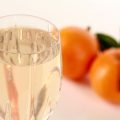


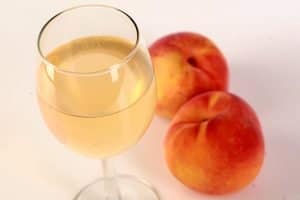

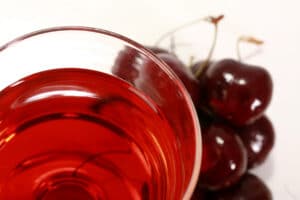
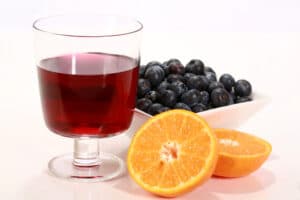
Tim
Marie.
In idea for your banana wine recipe. On your last racking before, bottling, add 1/2 cinnamon stick and 2 fresh limes sliced and juiced. It will tint the wine and greatly enhance the taste.
Thanks for the recipe.
Tim